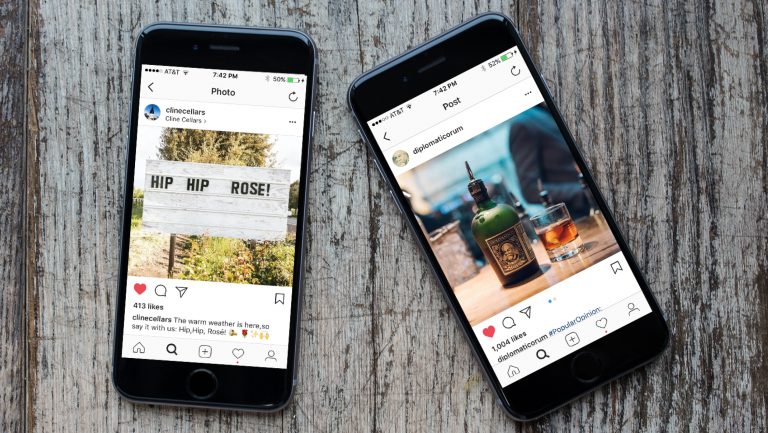Instagram and the drinks industry can be a perfect pairing for any digital marketing plan. Regardless of whether you’re a producer, an importer, a distributor, or you run a restaurant or bar, the social media network provides a level of engagement that not only lets your customers and fans connect directly with you but gives you a sense of how they’re responding to your offerings.
Whether you want to feature your latest concoction, the unicorn bottle you found in your cellar, or wistful pictures of budbreak or harvest, the kinds of content you can post on the picture-focused network are endless. But getting started or effectively keeping up with an Instagram account can be a bit intimidating and can easily fall to the bottom of a never-ending to-do list.
SevenFifty Daily reached out to social media strategists who work in the wine and spirits industries to learn more about creating—and maintaining—a successful Instagram presence.

Don’t miss the latest drinks industry news and insights. Sign up for our award-winning newsletters and get insider intel, resources, and trends delivered to your inbox every week.
Create a Strategy
Once you’ve set up your account, the secret to success comes down to “high-quality content, consistency in posting, and engagement,” says Celina Ticoll-Ramirez, an account coordinator at Polished Pig Media, a public relations firm with offices in New York City, Washington, D.C., and Charleston, South Carolina, that represents clients in the food, beverage, and hospitality industries. “There’s no perfect algorithm or ‘right’ way to use Instagram—you just have to find what works best for your brand.” And because social media is constantly evolving, she says, “you don’t want to be limited or held back by an overly rigid plan.”

How André Mack Uses Digital Media to Market His Wines
Apps harness the winemaker’s 100,000 social media followers for direct sales
And every brand is different. When we contacted Cline Family Cellars in Sonoma, California, to learn how the family winery approaches the social network, Megan Cline, who’s responsible for the winery’s communications and social media, was quick to note that bottle shots on their account don’t elicit nearly the same kind of engagement as other kinds of photos.
“Pretty vineyard shots always do really, really well,” Cline says. “Anytime I post photos of my parents [or] the winemakers, you actually see a lot more comments. People like people. They like seeing the story behind those posts.”
Maria Reask, the social media manager for Diplomático Rum’s Instagram account, says that for Diplomático, a Venezuelan brand, “the bottle shots do really well. They consistently get the most engagement because our followers love the brand and they recognize that label.”
To figure out what’s best for your brand, Ticoll-Ramirez suggests that you pay attention to the trends on your feed. “Look at the posts that have gotten the most engagement and reflect on how you created that post,” she says. “Carefully think through what you post and spend time crafting a caption and editing your images.” But don’t overthink it, she cautions, or make your feed too formal. “You still want your feed to feel personal.”
Build a Following
Photos should relate specifically to your “target demographic as well as fit the feel of your overall brand,” says Ticoll-Ramirez. But posting regularly is key. “Posting consistently for a week and then failing to maintain that frequency could lead to a drop in followers,” Ticoll-Ramirez says. “Engaging with users who comment on your posts, tag you in their posts, or [direct message] your page by liking tagged posts and responding to or liking comments is especially important.”
Also critical is to seek out those who are engaging with your brand through hashtags or geotagged posts. Recently, Instagram made this easier for users to do. “What’s awesome about Instagram is [that] you can follow a hashtag,” Cline says. “If anyone ever posts to #clinecellars, I can see that in my feed.”
Reask, who helped Diplomático Rum increase its followers from 8,000 to nearly 30,000 in two years, also points out that creating specific hashtags can encourage your followers to post pictures on their own feeds. In turn, she’ll post the fan photos on Diplomático’s feed. “It’s always important,” she says, “to give consumers validation of their attention to the brand.”
Brands can also work with influencers—tastemakers with a large Instagram following—to promote products or hashtags to their communities. Reask says finding influencers with like-minded audiences has helped increase Diplomático’s followers.
Edit Your #Hashtags
Many social media experts say that if you deploy too many hashtags or pile them onto your posts, you risk making your feed look disingenuous—as if you’re only posting to attract followers rather than wanting to be a part of the community. That’s why you’ll see—and many strategists will encourage—accounts hiding hashtags in a new comment or using several vertical dots under a caption to separate the hashtags from the main content of the post. It’s an easy way to connect to the larger Instagram world without disrupting your followers’ feeds.
“The most important thing,” says Ticoll-Ramirez, “[is] don’t overdo it. Know the hashtags that are relevant to the industry your brand is operating in and where your restaurant or bar is located.”
Cline also suggests citing popular lifestyle hashtags such as #pursuepretty and #livecolorfully in your posts, as long as they make sense with what you’re posting.
Stay Authentic
It’s Instagram, of course, so aesthetically arresting images will enhance your feed. But authenticity in your photos is also a key component to successful engagement. Hiring a professional photographer isn’t necessary, but images should be clear and be representative of your brand. Says Ticoll-Ramirez, “You want someone who is looking at your post to be able to envision himself or herself at your bar, sipping that drink.”
Shanika Hillocks, an influence relations manager at Colangelo and Partners, a public relations firm in New York City, and a SevenFifty Daily contributor, suggests that you think of Instagram the way you’d think of implementing a marketing strategy for a print magazine: “They say we eat and drink with our eyes first, we gather information via sight … In some ways, we’re not really reinventing this world. It just happens now to be in the palm of our hand.”
The trick is to make sure your posts don’t seem like advertisements or feel overly promotional. “You don’t want to send the message that you’re desperate to bring people to your business,” says Ticoll-Ramirez. “There’s no need to be extremely pushy when posting. And always do a gut check before posting an image and caption. You want to avoid posting any content that someone might find offensive, as today things can quickly escalate through social media.”
Experiment with Stories
About two years ago, Instagram introduced Stories, a feature that lets users post photos and videos that disappear after 24 hours. Ticoll-Ramirez suggests that the most effective way to use Stories is to post a behind-the-scenes look at your business and brand. “Stories is a great place to feature more raw and in-the-moment content,” she says. “Due to their limited life span, stories are a great way to experiment with new kinds of content [too]. Of course, don’t go completely rogue. Stay on brand still when posting to Stories, but have fun with it.”
Cline says she started using Stories because it helps make her account more discoverable. She takes advantage of her involvement in all aspects of her family’s business—from winemaking and helping in the vineyard to attending events—to tout the brand’s fuller story, using Stories to let her do some of that in a more casual way.
“I can use my iPhone and be like, ‘I’m enjoying Zinfandel with dinner,’ or whatever,” she says, “and then everything else you’re posting on your account can be really proper, buttoned up, and beautiful. Stories [posts] don’t have to be perfect, because they only last 24 hours.”

Dispatch
Sign up for our award-winning newsletter
Don’t miss the latest drinks industry news and insights—delivered to your inbox every week.
Alicia Cypress is following her passion for wine after spending more than 20 years as a journalist at National Public Radio and the Washington Post. She’s currently a managing editor at Reviewed.com, a part of the USA Today Network, and she writes a wine blog, itswinebyme.com. She’s received the WSET 2 certification (with distinction) and hopes to continue her studies. Talk about wine with her on Twitter or Instagram.







